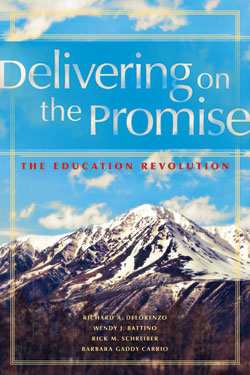Delivering on the Promise asks a lot of questions that need to be asked and prompts a lot of conversations that need to take place. Do students understand why they are learning what they are learning? Do students clearly know where they stand on mastering learning objectives in the classroom? Have we created a culture of learning for the sake of learning rather than a place where you come for a set amount of time each day for a particular number of days before you receive your report card?
I don’t agree with all of the points in this book, but there are several valid points related to standards based learning that focuses on mastery rather than a particular grade or assignment. A shift to this way of thinking would require a commitment from students, parents, and teachers to understanding that grades hold a different purpose…mastery is more important. How do you reconcile that will college admissions and other items like scholarships and that type of thing? The book also proposes doing away with grade levels or other categories related to age or number of years in school. How do you interact with things like the state athletic association that says that a person has 4 years of eligibility that starts the moment they start 9th grade? The PSAT is given to 10th and 11th graders. Would they allow an advanced 12 year old to take it even if they aren’t classified in those grade levels? I’m curious on how that would work in the college planning process with colleges and universities that are still pretty traditional in their thinking.
I appreciate the efforts in this book to put students, parents, and educators on the same side of the table with everyone playing a part in the learning process. I think that this book makes a case for a learning environment where more individual responsibility is placed on the student for their own learning…but creates a situation where this is communicated, assessed, communicated, assessed, and on and on in consistent dialogue using terms that are easy for all to understand. The main goal of this book seems to be to create a learning environment where students are truly learning what they need to be learning as they collect skills to be successful in life.
I highlighted several things while reading and have posted those notes below…
- Do you think that the assessments required by your state result in an accurate picture of student learning?
- One of the positive outcomes of No Child Left Behind is that for the first time, we as a nation are looking systematically at our schools, scrutinizing student achievement date, and evaluating how we do business in education. Accountability, accountability, accountability.
- For the most part, the US Education system ill-equips its students to succeed in this highly competitive, constantly changing environment. Although students leave high school armed with a stock of basic content knowledge, they largely lack the ability to apply that content knowledge in real-world settings. Today’s students—tomorrow’s employees—also need to learn and think on their feet, reason, creatively solve problems, and work in teams.
- The merging dynamics of global competitiveness and an increasingly technology-driven world point to the need to prepare students differently, in short, to prepare students to succeed in a world that does not yet exist.
- We have tremendous ground to cover to attain the performance levels US citizens desire for all of their students—to deliver on the promise of American education.
- The most fundamental difference between a traditional education system and a RISC system—one that translates into very practical differences—is that in a traditional system, time is the constant and learning is the variable. In a RISC system, the reverse is true: Learning is the constant and time is the variable.
- What are the burning issues and opportunities for improvement in your school or district?
- Do the educators in your system have regular, open, school wide, and districtwide conversations about student achievement?
- We have an opportunity to draw on everything we know about how students learn, and what makes school effective, to create a system that ensures that every child succeeds in fulfilling his or her highest dreams and abilities. The time is now.
- Are we making a difference? Is what we are doing helping students to be successful?
- What would a perfect class look like? What traits does an excellent teacher demonstrate? What kinds of things does a successful student do? How do you want to be treated? How should you treat others? What are the values and beliefs of a great classroom? What strategies do you need to be a successful learner?
- Are students keeping track of their own progress on standards?
- The RISC Approach to Schooling is an integrated standards-based system of education that represents a synthesis of research and best practice about high-performing organizations, educational excellence, the characteristics of effective schools, and fundamentals of human learning, engagement, and motivation.
- Even at a young age, students are very visible partners and co-creators in getting the most out of their education.
- Teachers make sure students know what they need to learn at each level, the kind of assessments that will be used, how they will be graded, and how their grades will be reported.
- Good teachers are always focused on how to do things better, reach students more effectively, and make learning more meaningful.
- Creating a vision of what is possible pulls us toward the future.
- Like students, teachers should be encouraged to change their perspectives of success and failure.
- Create a culture of learning.
- The great value of clear, continuous improvement tools, used across the system, is that taking time to evaluate and correct is prioritized. As educators, we typically plan and do, but rarely, if ever, take time to evaluate what we have done or make refinements. By instilling a shared commitment to the process of continuous improvement, we give permission and mandate time to evaluate what we are doing for effectiveness and success.
- Do my students know what they must accomplish to move to the next level? Is is clear to them what they need to learn? Can they explain that to someone else?
- Are there clear roadmaps in my classroom that explain levels of proficiency?
- Can students articulate your education system and their place in it?
Categories:



George Donovan
Megan,
You ask some really great questions that I think are definitely worth putting in front of administrators in places like college admissions, GHSA, GA Dept. of Education, and the organization(s) responsible for determining an age requirement for test taking.
Regarding athletics, it would seem equitable that students should be eligible to partake in athletics within an age range if minimums for educational achievement are in place. The student who is beyond “grade level” at a younger than typical age should not be penalized for that reason when it comes to concerns regarding fair competition and bodily maturity / injury.
Regarding required state testing or college entrance exams (SAT/ACT), I ask, why is age an issue for determining ability? The test outcome provides an indicator of an accomplished or unaccomplished level of performance for what is being tested for.
Again, you give awareness to some great points as provided in Delivering on the Promise. I believe the majority of parents would agree with the perspective of the authors regarding competency, grading, and advancement per the ability and performance of the student. The ReInventing Schools Coalition approach to learning is not the traditional industrial age model approach. It is based upon research and experience having been utilized now in state state school districts for up to 15 years. It is certainly an approach worth considering as student performance appears to be enhanced in several ways.
Thanks for your review and thoughts for everyone to consider.